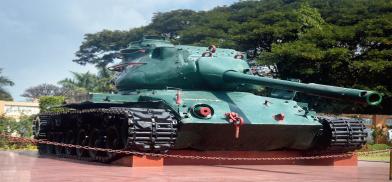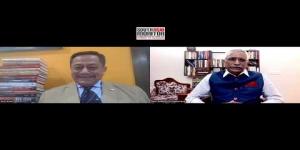Tank tales of an Indian Army veteran
I approached the bund in second gear and as the tank negotiated it, I saw Deepak descending from the top in free fall, headed for Mother Earth, and disappearing under the tank while I reflexively pressed the brake pedal.

Driving a battle tank can range from fun to fatigue in peacetime and frightful to fatal during war. Either way, it is unusual because, like a boat, it pitches, yaws or rolls depending on the kind of terrain it is negotiating and you steer it without a steering wheel or a handlebar. Like the joystick in an aircraft, there are sticks on either side of the driver to be pulled to turn the tank. The gears in most tanks are operated by a floor shift gear lever in between the driver’s legs or, in a few cases, automatic — no gear lever or clutch pedal — just the accelerator and foot brake.
The Armoured Corps is what used to be Cavalry in most armies. It was only after World War I that the process of mechanisation of cavalry units in armies began. Common to both equestrian and tank training is that the student spends some weeks just being made to study the steed or armoured vehicle from all directions, and in the stables/classrooms/garages before mounting and riding or driving it. Learning the use of a tank's weaponry from/on either comes later.
The thumb rule for any personnel riding on any tank is that they must hold on to some part of the tank to prevent being jettisoned. In this tale, the first tank I, an Indian Army officer, trained on was the good old trusty World War II vintage Centurion and the second was the Vijayanta, an indigenously made copy of the Vickers. While I trained on more tanks this tale is of driving these two named tanks during training, which ended well, in the sense that in the first case of the Centurion tank and in the second case my colleague both underwent some remarkable but quite repairable damage.
A grunting thud
During the first basic course for newly commissioned YOs (young officers) at the Armoured Corps School and Centre at Ahmednagar, Maharashtra, popularly known as “Nugger”, it was our second day of tank driving as the final part of the D&M (Driving and Maintenance) phase. On the first day, we had been driving over open stretches with gentle gradients. The next day’s schedule was negotiating restricted stretches like dry river beds. When my turn came, while I settled in the driver’s seat; 2/Lt Ashok Sharma, 3rd Cavalry, was in the commander’s hatch.
The instructor, an impressively moustachioed Dafadar (in Cavalry/Armoured Corps, Havildar/ Sergeant wearing three chevron stripes, is known as Dafadar) Hemraj Singh, of 64th Cavalry sat on the forward edge of the mudguard on the right side of the hull, close to the driver’s hatch, with a pointer staff to signal his instructions. Waiving the pointer staff forward (no matter how loud, the human voice cannot be heard above the tank engine’s noise), he bid me to move ahead and with a gentle lurch we were off onto the dry riverbed, soon cruising in fifth gear at about 30 kmph.
After a couple of kilometres, the negotiable stretch of the riverbed became so narrow that I had to keep my left track on the left bank. I was planning to make a slow right turn when this constriction opened out but the instructor, who was not too comfortable on the tilted tank, frantically waved his pointer staff to the right and I pulled the right stick swiftly. There came a very awkward grunting kind of sound followed by the tank’s sudden lateral movement to the right, which ended with a great thud. The instructor had nimbly jumped off the hull in those microseconds. And then I saw Ashok Sharma descend red-faced, wide-eyed and mouthing expletives.
Creating tank history
I switched the engine off and climbed out of the Centurion which was positioned 30 degrees to the horizontal — which meant at one critical moment Ashok Sharma must have been at 45 degrees and more than half out of the hatch. We saw to our chagrin that the right track had got ‘shed’ — rolled off the sprockets and got pushed to the hull’s outer wall. A “track-shed” requires the removal of a couple of track links and then aligning and re-fixing the track.
By now Risaldar Uppal, the JCO driving instructor— also of 3rd Cavalry — had arrived at the scene, followed by some of our course mates who jumped out of their tanks and converged to inspect our tilted tank. After 10 minutes of trying various track-link joints with a drift and a hammer, the grey-bearded Risaldar Uppal nodded his head solemnly and addressed me in Punjabi “Sir, never in my 30 years have I ever seen a track stretched so tight. I am afraid we will need to blast it with a GC (gun-cotton) slab”.
There followed a round of loud laughter and I was congratulated on creating minor tank history by all except Ashok, who launched on his hair-raising experience, all the while gesticulating wildly. The recovery of the Centurion after blasting its track was a long but riveting affair and in the evening at the bar of the old Cavalry Mess, drinks were toasted to the successful retrieval operation.
Course mishap
The second tale is about my driving the Vijayanta with Deepak Singh Kullar, then a fellow subaltern in my regiment, 4 Horse.
We had just converted to Vijayanta tanks after bidding a sentimental farewell to our Centurions, which had proved to be invaluable in both the 1965 and 1971 India-Pakistan wars, in which 4th Horse had destroyed a disproportionately large number of the then very modern Patton tanks gifted to Pakistan Army by the US. The Vijayanta’s turret has a metal basket at its rear which overhangs the driver’s hatch when the gun is locked to the rear of the hull during non-tactical moves. Deepak. clad in a black dungaree worn by the Indian Army tank crew, was accompanying me in the driving session.
Instead of sitting on the hull or standing in the commander’s hatch, Deepak chose to perch himself on the edge of the turret with one Wellington booted foot in the metal basket and the other dangling on the knee — the very picture of nonchalance. This was in typical Punjab countryside where you get open stretches with gentle undulations and bunds or embankments, separating harvested fields.
The instructor for this drive was Risaldar Joginder Singh, sitting on the hull front next to the driver’s hatch. After going through the lengthy procedure of starting the engine I signalled to him that I was ready to march off. He pointed his pointer staff straight ahead and I “stepped on the gas”. The entire circular course was about eight km and after cruising uneventfully — that means pitching, yawing and rolling at about 30 kmph - I saw an unusually high bund and eased my foot off the accelerator.
I approached the bund in second gear and as the tank negotiated it, I saw Deepak descending from the top in free fall, headed for Mother Earth, and disappearing under the tank while I reflexively pressed the brake pedal. I switched off the engine and anxiously climbed out only to see a dazed Deepak, minus his turban, crawling out from below the tank hull massaging his right hand’s middle finger, his black dungarees and beard all brown with dust.
Risaldar Joginder urged me to get right back into the driver’s seat and resume the course, while Deepak went to consult the surgeon who treated him with a plaster cast for his right middle finger which remained bent forward standing out during saluting for the next few weeks.
The epilogue is that Ashok Sharma, Deepak Kullar, Risaldars Uppal and Joginder, Dafadar Hemraj Singh and this writer, by God’s grace, all retired happily from the Indian Army.
(The author is a former spokesperson of the Indian Army and Ministry of Defence. Views are personal. He can be contacted at wordsword02@gmail.com)
Мы специализируемся на создании красивых, функциональных и долговечных тротуаров,
которые будут радовать вас и ваших гостей годы на протяжении многих лет.
укладка плитки тротуарной в частном доме - <a href=http://www.ukladka-trotuarnoj-plitki1.ru>https://ukladka-trotuarnoj-plitki1.ru</a>
Выполнение всех этих этапов гарантирует создание надежного тротуарного покрытия,
способного выдерживать как высокую пешеходную нагрузку, так и стоянку автомобилей.
Мы предлагаем быструю укладку тротуарной плитки в Краснодаре с учетом ландшафтного дизайна.
Мы готовы приступить к работе в соответствии с оговоренными объемом и сроками, обеспечивая высокое качество и
сохранение ландшафтных особенностей вашего участка.
----------------------------------------------------------------------------------------------------------------------
Заказать укладку тротуарной плитки - только в нашем фирме вы найдете высокое качество исполнения.
Быстрей всего сделать заказ на <a href=https://ukladka-trotuarnoj-plitki1.ru/>укладка плитки тротуарной в частном доме</a> можно только у нас!
Коллекция игр содержит классические автоматы и актуальные новинки с качественной анимацией и специальными возможностями.
Каждый слот разработан для максимального удовольствия как на десктопе, так и на планшетах.
Независимо от опыта, здесь вы обязательно подберёте слот по душе.
<a href="https://champion-casino-igr12.top">сайт champion casino</a>
Слоты доступны без ограничений и не требуют скачивания.
Кроме того, сайт предлагает акции и рекомендации, чтобы сделать игру ещё интереснее.
Начните играть прямо сейчас и испытайте удачу с казино Champion!
Мы организуем помощь в сфере сыскной деятельности.
Группа сотрудников работает с повышенной дискретностью.
Мы берёмся за сбор информации и выявление рисков.
<a href="https://justkidding-me.com/">Заказать детектива</a>
Каждое дело получает персональный подход.
Задействуем проверенные подходы и работаем строго в рамках закона.
Ищете реальную помощь — свяжитесь с нами.
You can check out urban and classic styles to fit your home.
Each piece is carefully selected for its craftsmanship and reliable performance.
Whether you're decorating a functional kitchen, there's always a matching clock waiting for you.
<a href="https://www.clocksforlife.com/waterford-crystal-table-clocks/">waterford crystal table clocks</a>
Our assortment is regularly renewed with fresh designs.
We focus on customer satisfaction, so your order is always in professional processing.
Start your journey to better decor with just a few clicks.
Visitors can experience retro-style games as well as new-generation slots with vivid animation and interactive gameplay.
If you're just starting out or a casino enthusiast, there’s a game that fits your style.
<a href="https://windlounge.de/">casino games</a>
The games are available round the clock and compatible with laptops and mobile devices alike.
No download is required, so you can start playing instantly.
Site navigation is easy to use, making it convenient to explore new games.
Register now, and discover the thrill of casino games!
Users can enjoy traditional machines as well as new-generation slots with high-quality visuals and interactive gameplay.
Whether you’re a beginner or a casino enthusiast, there’s a game that fits your style.
<a href="https://windlounge.de/">casino games</a>
The games are available 24/7 and designed for PCs and mobile devices alike.
You don’t need to install anything, so you can start playing instantly.
Site navigation is user-friendly, making it simple to find your favorite slot.
Sign up today, and dive into the world of online slots!












Post a Comment